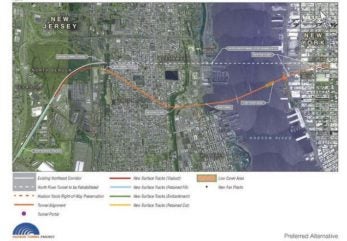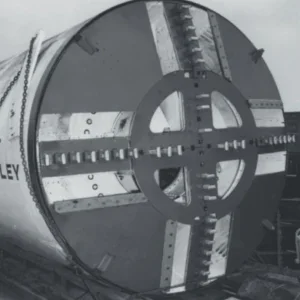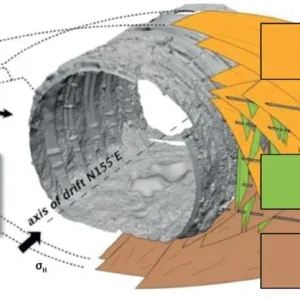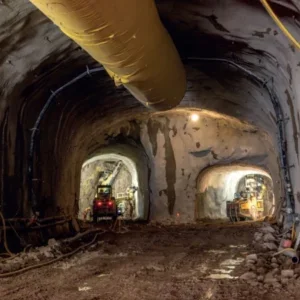
Numerous investments have been made to use underground space for public infrastructure in New York city and state, and more projects are underway.
This snapshot gives a brief view upon a few such current investments – in transport and public health and environmental improvement infrastructure.

On transport, below is a marker update on the twintube Hudson Tunnel Project to provide a new rail link between Manhattan, in New York city, and New Jersey on the other side of the Hudson River. Much preparatory work is needed. There is also refurbishment of an existing rail tunnel as part of the huge project.
Also on transport, and on preparatory works too – and still in Manhattan, but to the northeast – is a further rail transport investment but this time on the sub-sector of subway networks. The early works for the next stage of Second Avenue Subway are underway (see box panel-1).
This snapshot gives a brief view upon a few such current investments – in transport and public health and environmental improvement infrastructure. We look at Hudson Tunnel Project to provide a new rail link between Manhattan and New Jersey; early works for the next stage of Second Avenue Subway, also in Manhattan (see box panel-1); and, outside the city, a treated wastewater conveyance tunnel on Long Island (see box panel-2).
FIRST HEAVY CIVILS CONTRACT FOR HUDSON TUNNEL
The Gateway Development Commission (GDC) has awarded the Hudson River Ground Stabilisation (HRGS) Project to Weeks Marine, marking the first heavy construction contract for the Hudson Tunnel Project (HTP).
The US$284m HRGS Project will modify conditions in the Hudson River to allow the tunnel to be excavated by tunnel boring machine (TBM). In the low-cover area of the Hudson River off Manhattan’s shoreline, the riverbed comprises silt too soft to support a tunnel. By injecting grout into the silt, columns of soil mixed with cement and water will stabilise the ground above the future tunnel. Temporary sheet pile cofferdams will enclose the work zone, enabling in-water ground improvement to be completed one phase at a time, beginning in the section of the river closest to Manhattan and moving westward toward the Hudson River’s navigation channel.
Weeks Marine will begin work this year. Phase One of the project, to be undertaken from Spring to Fall, includes surveying and also the design and construction of a test cofferdam. Phase Two, from Fall to Spring 2027, includes the design and construction of the remaining works related to the HRGS Project.
The GDC said that, in authorising the Hudson Tunnel’s first heavy construction work, “we are one step closer to crossing the Rubicon and securing this tunnel’s future. Work is on-track and there can be no turning back on the 21st century transportation experience our riders have long been waiting for.”
The US$16bn Gateway Programme involves building a new 3.85km-long two-tube tunnel under the Hudson River, between Newark, New Jersey, and New York City’s Penn Station, and refurbishing Amtrak’s existing 112-year-old North River rail tunnel, which was badly damaged by Hurricane Sandy in 2012.
In November last year, ground was broken on both sides of the Hudson River, with construction under way on the Hudson Yards Concrete Casing: Section 3, on Manhattan’s west side, and on the Tonnelle Avenue Bridge and Utility Relocation Project, in New Jersey.
The Hudson Yards Concrete Casing: Section 3 project is preserving an essential right-of-way to guarantee the new tunnel’s connection to New York Penn Station.
Five out of the nine packages for the Hudson Tunnel Project are either in procurement, awarded, or under construction.
CONTRACTS START ON SECOND AVENUE SUBWAY EXTENSION
First contract awards have been made for New York subway extension Phase 2 – on the about-to-be-enlarged Second Avenue Subway.
New York’s Metropolitan Transportation Authority (MTA) has awarded the first construction contract for the extension of the Second Avenue Subway in Harlem.
CAC Industries won the US$182m contract to relocate underground utilities from 105 Street to 110 Street on Second Avenue at the site of the future 106 Street Station, to allow the subsequent cut-and-cover construction of the station. The contract also includes temporary streetscape modifications that will be required during construction.
It is the first of four construction contracts for the new line, which will extend the Q train approximately 2.4km from 96 Street to 125 Street and provide three new accessible stations for the East Harlem community. New York City has some of the most complex underground utilities networks in the world – much of which is unmapped – which can add delays and costs once projects are underway.
Announcing the contact award, New York’s Governor Kathy Hochul said advancing utility relocation ahead of station and tunnel construction was a major lesson learned from Phase 1 of Second Avenue Subway.
MTA’s Construction and Development president, Jamie Torres-Springer, echoed that valuable lessons learned from past projects were being implemented into Phase 2 of the Second Avenue Subway.
“This contract reflects our new approach by proactively relocating utilities upfront. Improving this process will help deliver this project more efficiently and provide residents of East Harlem with increased transportation options better, faster, and cheaper than before,” he said.
Revenue from congestion pricing will support US$15bn in funding for critical projects in the MTA’s current capital programme, which includes Second Avenue Subway Phase 2.
Additional cost containment initiatives in Phase 2 include reuse of a tunnel segment that was built in the 1970s from 110 Street to 120 Street along Second Avenue, early real estate acquisition, adoption of ‘best value’ contract structures (such as A+B contracts), reduction in back-of-house and ancillary space, and close co-ordination of contracts.
Phase 1 of the project extended the Q line from 63 Street to 96 Street and was New York City’s largest expansion of the subway system in 50 years. Since opening in January 2017, the Second Avenue Subway has carried more than 130 million passengers in total, including over 200,000 passengers on a typical pre-pandemic day.
TUNNELLING COMPLETED ON LONG ISLAND PROJECT
Tunnelling works have been completed on the Bay Park Conveyance Project in New York state.
The project to improve Western Bays, on Long Island, will convey treated wastewater for eventual offshore disposal. It has involved nearly 17.7km of microtunnelling and around one mile of sliplining of an abandoned 100-year-old aqueduct pipe.
Working on a Design-Build contract, Western Bays Constructors, a joint venture of John P Picone and Northeast Remsco Construction, began works in 2021. Fourteen shafts were built and the two micro tunnel boring machines (TBMs) were launched in 2022. Twelve tunnelling drives were completed to lay the 1.8m-diameter tunnel at depths of 5.8m-7.9m.
Microtunnelling was chosen for the project to minimise disturbance to surrounding communities, reduce cost and accelerate construction.
The project investment is to reduce nitrogen pollution in Long Island’s Western Bays. It will redirect treated water through a pollution control plant to an Atlantic Ocean outfall.
“The Bay Park Conveyance Project is one of the most innovative infrastructure projects in the nation and an example of our State’s commitment to securing a healthier and more sustainable future for New Yorkers,” said New York’s Governor Kathy Hochul. “With the conclusion of this phase of work, we are making important progress to ensure Long Island has access to clean water and create healthy and resilient ecosystems.”







